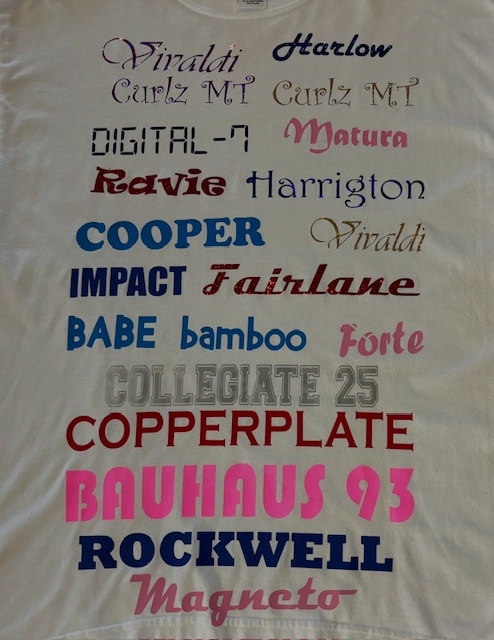Heat Transfer on T-Shirts and Aprons - Personalized Styles and Logo Designs
The Art of Personalized Needlework: Opening the Tricks to Creating Special and Unforgettable Styles
Needlework, a craft steeped in tradition and artistry, holds within its elaborate stitches the power to change material into a canvas of special expression. The tricks to producing customized embroidery designs that captivate the eye and leave a lasting impact hinge on a fragile balance of method, creativity, and attention to information. As we dig into the world of custom embroidery, we reveal the nuanced interaction in between string option, sew complexity, and design customization that raises a mere garment to an artwork. Join us on a journey via the art of custom needlework as we untangle the enigmas behind crafting genuinely extraordinary and distinctive creations.
Choosing the Right Embroidery Threads
When picking embroidery strings, what vital variables should you take into consideration to guarantee the best outcomes for your custom-made styles? The choice of needlework thread is essential in identifying the last end result of your stitched style.
Furthermore, the weight or thickness of the string plays a considerable role in the look of the needlework. Thicker strings can include dimension and structure to your layout, while finer threads are perfect for intricate information and tiny message. In addition, thinking about the color fastness and washability of the thread is critical to make certain that your custom layouts keep their top quality and vibrancy over time. By very carefully evaluating these factors and choosing high-quality threads that meet your specific requirements, you can boost the visual charm and durability of your stitched productions.
Checking Out Various Stitch Methods
To look into the world of 'Discovering Different Stitch Strategies', one need to grasp the complexities and nuances that each stitching method brings to the art of embroidery. Various stitch techniques not only include aesthetic passion yet likewise add to the general structure and dimension of the design. One preferred stitch technique is the satin stitch, which involves very closely stuffed parallel stitches to produce a smooth and shiny surface, perfect for completing forms and producing bold outlines.
On the various other hand, the backstitch is a flexible method typically used for outlining and including fine details. It entails stitching backward to develop a solid line of embroidery. In addition, the French knot stitch includes a tactile component to styles, perfect for developing textured accents like blossom facilities or decorative touches.
Discovering various stitch methods allows embroiderers to have fun with light, shadow, and deepness within their styles, elevating the aesthetic appeal and imaginative quality of their embroidery tasks. By mastering numerous stitching approaches, one can unlock countless possibilities for developing distinct and memorable custom-made needlework pieces.
Incorporating Personalized Layout Elements
Having discovered the intricacies of different stitch techniques such as the satin stitch, backstitch, and French knot, the focus now shifts towards integrating individualized layout components in personalized needlework tasks. Individualized layout elements play a crucial duty in making embroidery tasks truly special and memorable.
One more means to include individualized design components is by consisting of symbols or themes that hold special definition to the recipient or show their rate of interests and individuality. Integrating a favorite blossom, animal, or hobby-related symbol can make the needlework style more purposeful and individualized. Furthermore, choosing shades that resonate with the recipient or straighten with the designated theme can better improve the customization of the embroidery project.
Grasping the Art of Color Sychronisation

One monogramming on towels key facet of color control is comprehending color concept. This includes recognizing exactly how different shades communicate with each various other, the emotions they share, and exactly how they can be combined to produce visually attractive designs. By using color concept principles, embroiderers can create harmonious shade combinations that boost the general appearance of the style.
In addition, taking note of contrast is vital in color control. Utilizing contrasting shades can help particular elements of the style pop, boost legibility, and produce an aesthetically dynamic needlework piece. By grasping the art of shade coordination, embroiderers can raise their layouts and create unforgettable items that reverberate with clients and customers alike.
Enhancing Appearance With Advanced Embroidery Stitches

French knots, as an example, are best for including tiny, elevated dots to your layout, mimicking the look of beads or creating a textured surface. Bullion knots, on the other hand, can be used to create twisted, ropelike elements that add a luxurious feel to the embroidery. Seed stitching involves tiny, scattered stitches that can fill in areas with a polychromatic texture, while turkey work develops cosy, dimensional accents evocative pet hair or foliage. Trying out these sophisticated embroidery stitches allows you to press the borders of typical needlework and produce genuinely special and visually appealing textures in your designs.
Conclusion
To conclude, the art of custom-made embroidery entails a combination of choosing the appropriate strings, exploring numerous stitch methods, incorporating personalized style elements, understanding color control, and improving texture with innovative stitches. By comprehending and carrying out these crucial elements, embroiderers can develop one-of-a-kind and remarkable styles that display their imagination and ability. Embroidery lovers can open the secrets to developing lovely and bespoke pieces that attract attention and leave a long lasting impact.